
MAY CONTAIN NUTS

Search Shorpy
SHORPY ART

Framed or unframed, desk size to sofa size, printed by us in Arizona and Alabama since 2007. Explore now.
Join and Share
Ad-Free Shorpy
Shorpy is funded by you. Patreon contributors get an ad-free experience.
Learn more.

Recent comments
- Details, Details
- What's that building to the left of the tower?
- Coal Barges
- Bromo-Seltzer
- Inner harbor
- The Basin
- What a headache!
- Giant stepladder?
- Baldwin 62303
- Baldwin VO-1000
- Cold
- No expense spared
- Tough Guys
- Lost in Toyland
- And without gloves
- If I were a blindfolded time traveler
- Smoke Consumer Also Cooks
- Oh that stove!
- Possibly still there?
- What?!?
- $100 Reward
- Freeze Frame
- Texas Flyer wanted
- Just a Year Too Soon
- WWII -- Replacing men with women at the railroad crossing.
- Yes, Icing
- You kids drive me nuts!
- NOT An Easy Job
- I wonder
- Just add window boxes
Member Photos
The Shorpy
Print Emporium
Print Emporium
Search Shorpy
Search results -- 30 results per page
- Washington's Finest: 1927
- 1927. "Skinned frankfurts, made in Washington, D.C." What Bismarck said about laws and sausages: It turns out you ... Posted by Dave - 07/18/2013 - 7:32am -
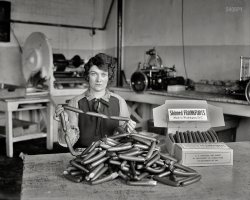
- Miss Washington: 1922
- 1922. "Miss Washington in bathing suit." Concealed yet revealed, Evelyn Lewis at the Wardman Park Hotel pool on a nippy day. Harris & Ewing. View full size.
Nice Shoes?
The Look Was Common In The 20s Thin loose fitting clothi ... Posted by Dave - 04/30/2013 - 11:01am -
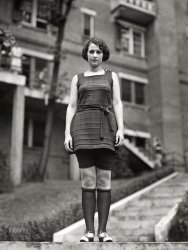
- Ask Mr. Foster: 1924
- ... boy who appears in numerous photos around Washington DC?
Count the Times We could almost make a game of how many times the ... wood, china, leather. There are picture books of views of Washington, and all sorts of things suitable as gifts. Many of these things ... Posted by Dave - 09/03/2012 - 3:36pm -
![Ask Mr. Foster: 1924 "Foster & Reynolds, exterior." The National Remembrance Shop in Washington circa 1924. View full size. National Photo Company Collection glass negative.
Ask Mr. EgoI want to ask Mr. Foster how he got to be such a Mr. Knowitall.
Question for Mr. FosterWho was the ever enigmatic Edwards boy who appears in numerous photos around Washington DC?
Count the TimesWe could almost make a game of how many times the phrase "Ask Mr. Foster" appears in this shot.
Mr. Foster's ShopWashington Post, Apr 17, 1922; advertisement
Every one visiting Washington wishes to take away something as a remembrance of the visit to the Nation's Capitol or as a gift for friends at home. It is the aim of the National Remembrance Shop to supply such things in souvenirs that shall have some artistic merit.
Our wares are of gold, silver, wood, china, leather. There are picture books of views of Washington, and all sorts of things suitable as gifts. Many of these things cannot be had elsewhere. We mean that the prices shall be reasonable, the goods well and servicable, and pleasing to the eye: even the most inexpensive articles (and there are many such) being of a character to appeal to persons of cultivated taste.
National Remembrance Shop
(Mr. Foster's Shop)
503 14th St., One Door from Pennsylvania Ave.
Opposite Willard Hotel
Wallace NuttingA number of the framed images in the window were made by Wallace Nutting, a Congregational Minister turned photographer and entrepreur. In particular, the images in the top of the central window appear to be very similar to "A Plate of Cookies - Studio #67" by Nutting.
http://www.wallacenuttinglibrary.com/wnp00067.htm
A.M.F. CountI come up with 10 readable Ask Mr. Fosters.
National Remembrance ShopThe following appears as an advertisement in the Washington Post in 1915:
Remembrances of Washington that are attractive yet inexpensive. National Remembrance Shop,14th St. and Pa. Ave.
Pre-GoogleAsk Jeeves' great-granddad.
On the SillIn the left window, there are five publications, one with the Statue of Liberty on the cover. Are these atlases, maps, or travel magazines?
[Travel guides ("Standard Guides") to Washington, Boston, New York, Chicago and Illegible. - Dave]
Reynolds' Standard Guide Washington Post, Nov 11, 1940; obituary
Charles Bingham Reynolds, editor of a sightseeing guide of Washington and brother of Burnet Reynolds of 1411 Crittenden Street Northwest, died yesterday at his home in Mountain Lakes, N.J., at the age of 84.
Mr. Reynolds was one of the founders of the B.S. Reynolds Co. here, a wholesale souvenir and postcard company. He was editor of Forest and Stream from 1879 to 1906. He was the author of a number of travel guides including "Old St. Augustine, a Story of Three Centuries" and "Standard Guide to Cuba." He founded the Foster and Reynolds Travel Service more than 50 years ago, and served as secretary and treasurer.
Standard Guide of Washington at Google Books
That hill!Ha! I was going to guess 14th Street, because you just don't see streets slope that way too many places in downtown Washington.
How Could I Miss It?I didn't get to Illegible on my trip to the US! Bummin' looks like a fine town.
Ask Mr. FosterWard G. Foster started the "Ask Mr. Foster" travel agency in St. Augustine, Florida in 1888. The store was part of a building recently restored as the Casa Monica Hotel.
If anyone has a copy of the 1937 publication of "Ask Mr. Foster" by Charles B. Reynolds. Please contact
gary@adlibtours.com
National Remembrance ShopI have just bought a jug here in the UK. 9.5 inches tall, Treacle Brown Glazed, with a print of the White House on one side and the Congressional Library on the other. On the bottom it is marked "National Remembrance Shop Washington DC." It looks very like the jug in the window. Far left above the second plate from the left behind the two tankards. More pics here.
(The Gallery, D.C., Natl Photo, Stores & Markets, Travel & Vacation)](https://www.shorpy.com/files/images/31653u.thumbnail.jpg)
- Old Hat: 1920
- Washington, D.C., circa 1920. "814-816 Ninth Street N.W." Moldy negative of a ... Posted by Dave - 04/06/2013 - 12:01pm -
![Old Hat: 1920 Washington, D.C., circa 1920. "814-816 Ninth Street N.W." Moldy negative of a decrepit storefront, with many musty details. National Photo Co. View full size.
Motocycles?I just learned that the folks at Indian didn't know how to spell "motorcycle."
The Indian Motocycle shopI find the partial view of the Indian Motocycle shop more interesting than the almost-derelict storefront that's the subject of the photo. Here's a photo of a 1920 Indian Motocycle; the "Indian" name and the fuel tank (I assume) it's on look the same as in the window of that shop.
http://parkerindian.com.au/1920PP.html
"Silent" OlsonThe poster above the For Rent sign is for a wrestling match between Joe Turner and Silent Olson, a deaf-mute.
"Christmas night he beat Joe Turner, for ten years champion middleweight wrestler."
They came and went.BEAUTIFUL Indian in the window next door.
One please, to go !
Washington RedskinsWhile the out of business hat store has its decrepit charm the store to the left has much more to offer. Indian brand motorcycles, bicycles and tricycles are all on display. What a treasure trove. Also,the reflection in the hat store window shows cars in the street and what looks like someones legs on a ladder or scaffold rung. I wonder if it is somebody in the store working or perhaps the reflection of the photographer in the street getting a raised perspective. The Gold Medal Flour sign up above states "Why Not Now?" No time like the present indeed.
Elementary ParticlesNot sure, but that curved white line with the little black teardrop at the top ... I think it's the Higgs Boson!
New HatIt's all gone now, replaced by the U.S. Mint Headquarters.
View Larger Map
Lady of the Lamp Looks like she left it on the sidewalk in front of the Indian dealership. Also looks like the rear of the hat store has collapsed.
Sniper!Top window, second floor! Or maybe it's some sort of Rube Goldberg drainage system.
The Lady of the LampThe sign in the window to the right is a play by Earl Carroll, closed November 1920. The sign states Dec. 6. Seems it never made it to that date.
http://www.ibdb.com/production.php?id=8963
[December 6 is the performance date in Washington. The Broadway Database dates are for performances on Broadway, in New York. - Dave]
Motocycles and motorcyclesThe corporate name was always "Indian Motocycle Company" but it made motorcycles and advertised them as such. Well the nearly new 1946 Chief I owned was called a motorcycle, but company name was still "Motocycle." Dang, I sold the thing for $75 in 1958 to a guy who had never ridden one. I had to drive the bike into his pickup truck and he said he was going to unload it in a 40 acre pasture and learn to ride. He figured there weren't many things to hit in a pasture except for the cow patties.
Too dark to see in the daytimeWhat's with the kerosene lantern on the sidewalk?
Now a Parking LotNo, not the U.S. Mint headquarters; that's on the east side of Ninth Street, the odd-numbered side. Where 814-816 Ninth Street was is now a vast parking lot, where the old new Convention Center used to be, till it was mercifully torn down. Even a parking lot is preferable to that awful building. If the Hoover FBI building and the OPM building at 20th and E could go the way of the old new Convention Center, even if they became nothing but parking lots, Washington would be a better place.
F.L. Leishear, Indian MotorcyclesThat's F.L. Leishear's motorcycle shop to the left, also seen in Shorpy post Wireless Apparatus: 1919. The previously open D. Neufeld Hat Manufacturer has since closed and lost its most prominent signage.
Washington Post, Jun 23, 1921
Motorcycles
PRICES reduced 20% on new 1921 Indian motorcycles and side cars; also used machines at exceptional prices. F.L. Leishear, 812 9th st. nw.
A LeopardIt seems strange that there is a leopard skin in the Indian window.
One item that Indian made that does not appear to be on display is a canoe and trailer that can be used with a motorcycle.
(The Gallery, D.C., Motorcycles, Natl Photo, Stores & Markets)](https://www.shorpy.com/files/images/29720u.thumbnail.jpg)
- This Desirable Corner: 1901
- Washington, D.C., circa 1901. "View of E Street N.W., south side, looking west ... call box? Right on the corner, one of the ubiquitous DC call box frames for fire and police--though curiously missing its innards ... Posted by Dave - 12/19/2023 - 12:58pm -
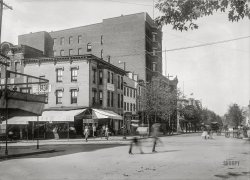
- Batista en Washington: 1938
- ... invitation of Undersecretary of State Sumner Welles. In Washington, Batista met with Secretary of State Cordell Hull and Roosevelt. ... Posted by Dave - 08/23/2012 - 6:18pm -
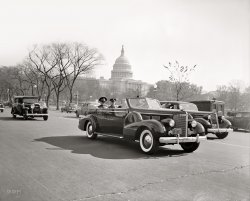
- Washington Flyer: 1921
- January 29, 1921. Washington, D.C. "Herbert Bell and Joe Garso." Evidently lost to history. Does ... Posted by Dave - 08/13/2013 - 4:09pm -
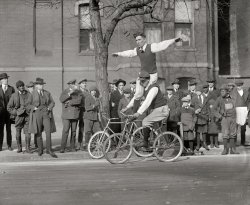
- Wartime Washington Monument: 1943
- November 1943. "The Washington Monument." The "tan line" a third of the way up shows where construction resumed in the 19th century after a hiatus of many years . Photo by Esther Bubley, Office of War Information. View full size .
That&# ... Posted by Dave - 08/14/2012 - 5:53am -
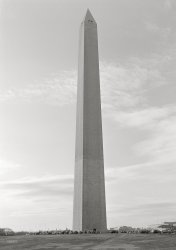
- Washington Gas Light: 1937
- Washington, D.C., 1937. "Washington Gas Light Co., 10th Street N.W." Current ... Posted by Dave - 12/28/2015 - 2:10pm -
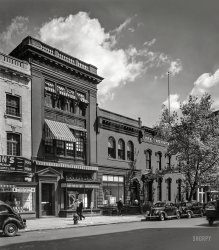
- Aerial Washington: 1911
- ... shaped slate turret would top off the projecting bay of a DC rowhouse. All four sides would have been slated. Slate, because of its ... talents - this was before I switched to digital.)
DC in 1911 What a great photo. More of these buildings than one would think ... Posted by Dave - 04/09/2014 - 1:24pm -
![Aerial Washington: 1911 Circa 1911. "Washington from Washington Monument." Points of interest in this first installment of a six-segment panoramic view include B Street (today's Constitution Avenue), running diagonally from the Potomac Electric powerhouse at lower left; Louisiana Avenue, branching off in the general direction of Union Station at upper right; the Old Post Office and its clock tower at left-center across Pennsylvania Avenue from the Raleigh Hotel under construction; the Agriculture Department greenhouses in the foreground with a corner of the Smithsonian "National Museum" at far right, just below Center Market; Liberty Market at upper left, below what looks to be a vast tent encampment; and, at right-upper-center, the Pension Office north of Judiciary Square and the District Court House. 8x10 glass negative, Detroit Publishing Co. View full size.
"Tents"All those tents are actually slate turret roofs on top of rowhouses. Very typically, a pyramid shaped slate turret would top off the projecting bay of a DC rowhouse. All four sides would have been slated. Slate, because of its mineral content (lots of mica) can be very reflective at certain angles, hence the white appearance.
[Conical was also popular. - Dave]
SurprisingSurprising lack of motorized vehicles for ca. 1911.
[Here are seven. - Dave]
Cargo TramNow there's something I had never really thought of: street cars for freight; a forerunner of today's semi-rigs I suppose. There's one being loaded/unloaded in front of the lumber yard.
First of six?Great! Bring them on!
Kann's Busy Corneraka Kann's Department Store. A good history of the life and death of the buildings can be found here.
[More here. - Dave]
+86Below is the same view taken in December of 1997. (Please excuse my still-limited scanning talents - this was before I switched to digital.)
DC in 1911What a great photo. More of these buildings than one would think are still there. The "District Court House" south (right) of the great Pension Building on Judiciary Square is the original DC City hall, started in 1820. After a several-years-long redo, it now houses in grand style the DC Court of Appeals (the state supreme court for the District.) Peeking around the office building to the left of the City Hall on 5th Street NW is the then-new US Court of Appeals building, which housed what is now the US Court of Appeals for the DC Circuit until 1952, when it moved to the new federal courthouse on Constitution Avenue (now the Prettyman Courthouse.) The old US Court of Appeals building now houses the US Court of Appeals for the Armed Forces, on which I am privileged to sit. It is an exquisite little building, quite well-preserved, with many of its original furnishings.
Ford's TheaterI had a thought that Ford's Theater was off in this general direction, so I took a look. Not being all that familiar with D.C. I'm wondering if that is the peak of the theater with porthole just above the scaffolding atop the hotel under construction.
(The Gallery, D.C., DPC, Railroads, Stores & Markets, Streetcars)](https://www.shorpy.com/files/images/SHORPY_4a10391a.thumbnail.jpg)
- Washington Sleeps Here: 1922
- Washington, D.C., circa 1922. "New Jersey Avenue S.E. from B Street." Lodgings ... Posted by Dave - 05/14/2014 - 12:01pm -
![Washington Sleeps Here: 1922 Washington, D.C., circa 1922. "New Jersey Avenue S.E. from B Street." Lodgings in this view from the House Office Building include the Potomac, Congress Hall and President hotels (sign at left), as well as the George Washington Inn. National Photo Company Collection glass negative. View full size.
Always One in Every CrowdAll the cars parked left to right except one. That owner backed in.
Even Then --Looking at the car parked at the end on the bottom right, I see that pulling in straight and taking only one spot was not all that important even in 1922.
Hotel PotomacThe Hotel Potomac across the street retains at least some of the structure, and sits on the same site, of the old Conrad and McMunn boardinghouse, where Thomas Jefferson lived while he was vice president. Alas, that whole block would be razed in 1929.
What a beautiful sidewalkThat would be the envy of any city today.
There it isWhat would a Shorpy photo be like if there were no milk bottles on the window sill?
Interesting vehicleAnyone know what kind of car the 3rd car from the right is? Unusual as it has no front radiator.
[It's a circa 1916 Franklin, which used an air-cooled engine. - Dave]
Car ID's suggestionsFront row R to L: Studebaker; Star; Franklin; Velie; unknown; Ford; Studebaker; Studebaker; Haynes; Ford; Dodge(dirty); Pierce-Arrow; Studebaker; Buick; 2 Ford coupes; hidden car; Ford sedan etc. Back row two cars in front of bus and three directly in back are all Fords including one converted to a truck. Car with plate 10845 with knife edge styling is a Hudson. Others need more study.
The House SideThe hotels are on the present site of the Longworth House Office Building. The Cannon Building, from which the photo was taken, was built about 1908. B Street is now Independence Avenue; the photo looks toward C Street SE. South Capitol Street, which divides the quadrants, is a block west (right) between Longworth and the Rayburn Building, which was built in the early 1960s.
Something's WrongIt's actually several years past 1922.
The District of Columbia license plates seen on the cars indicate that this photo was actually taken in 1925. The format of the 1925 D.C. plate, with "Dist. Col. 1925" between the bolt slots is a one year only feature.
Confirming the date is the presence of a late 1924 or 1925 model Pierce Arrow Model 80 (12th car from the right).
Other cars at the beginning of the row:
1920-1921 Studebaker Big 6 (Model EG)
1922 Star (made by Durant Motors)
1914 - 1916 Franklin Series 8 (note electric lights)
1925 Cleveland Six Model 43
1920 - 1922 Oldsmobile Model 46
Ford Model T
Note how few cars have front wheel brakes.
(The Gallery, Cars, Trucks, Buses, D.C., Natl Photo)](https://www.shorpy.com/files/images/SHORPY-31742u1.thumbnail.jpg)
- Washington à Go-Go: 1917
- 1917. "District of Columbia -- traffic Stop & Go signs." From the birthplace of that musical genre, perhaps the earliest visual representation of "go-go." Raleigh Hotel in the background. Harris & Ewing Collection glass negative. View fu ... Posted by Dave - 05/06/2014 - 8:44am -
![Washington à Go-Go: 1917 1917. "District of Columbia -- traffic Stop & Go signs." From the birthplace of that musical genre, perhaps the earliest visual representation of "go-go." Raleigh Hotel in the background. Harris & Ewing Collection glass negative. View full size.
One fine motor carI sure hope one of our eagle-eyed regulars can ID that auto!
Newspaper RowForeground is the 1300 block of Pa. Ave NW. Visible at top left is the Washington Post building (1339 E St.) and the Munsey Trust Building (1327-29 E St., housing the Washington Times), seen previously on Shorpy here and here.
Haynes RoadsterThe Haynes was manufactured in Kokomo, Indiana, from 1905 until 1924 by Elwood Haynes and brothers Edgar and Elmer Apperson. Before that, they produced the Haynes-Apperson from 1896 as the first automobile manufacturer in Indiana and one of the earliest in the United States.
Another pic of the same car is here.
License and registration, pleaseAs seen from a different angle, this car has license number 41441. According to the Sept. 17, 1916 Sunday Star, that tag was issued in early September 1916 to the Haynes Motor Company for use on a demonstration vehicle.
HaynesThis is actually a 1917 or 1918 Haynes Light Twelve Cloverleaf Roadster.
Newspaper Row, ctd.And don't forget the Evening Star, in the background.
That hotelI believe the hotel in the background is the famous Willard Hotel, not the Raleigh. It still stands.
[It's the Raleigh. -tterrace]
Test-TestThe Evening Star reports on the go-go experiment in October 1915 and its implementation in November of the same year.
Same architect.I understand FloridaClay's confusion. Both hotels were designed by architect Henry Janeway Hardenbergh who apparently liked the style. The Willard is a decade older and a floor shorter than the Raleigh.
(The Gallery, Cars, Trucks, Buses, D.C., Harris + Ewing, Streetcars)](https://www.shorpy.com/files/images/SHORPY_13275a.thumbnail.jpg)
- Washington's Shadow: 1942
- ... Franklin D. Roosevelt, Dec. 8, 1941
March 1942. Washington, D.C. "Construction of temporary war emergency buildings on the ... Posted by Dave - 11/23/2020 - 3:22pm -
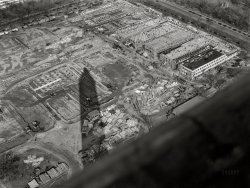
- Oysters Hot Waffles: 1920
- ... that corner now.
http://en.wikipedia.org/wiki/1968_Washington,_D.C._riots
On a brighter note, I live only a few blocks from ... Posted by Dave - 10/05/2022 - 5:21pm -
![Oysters Hot Waffles: 1920 Circa 1920. "Herald, Seventh and H streets N.E." Continuing our culinary tour of the nation's capital, we present the New Olive Cafe, next door to H. Bennett, Barber, and Blechman's Fashion Shop. National Photo Company glass negative. View full size.
GoneThe building housing the Laundromat is still there, but the turreted building on the corner is long gone.
[Wrong corner. See above. - Dave]
View Larger Map
Gus Blechman
Washington Post, Dec 5, 1965
Washington Storekeeper, Gus Blechman
Gus Blechman, owner of Blechman's Fashion Shop on H Street ne. until his retirement 20 years ago, died Saturday at his home, 4201 Cathedral ave. nw. He was 94.
A Russian immigrant, he lived for several years in Richmond before coming to Washington in 1916. He was an H Street merchant for more than a half century. Mr. Blechman was a member of Adas Israel Synagogue.
Surviving are his wife, Mary; three sons, Sylvan of 4000 Massachusetts ave. nw.; Nelson, of 5034 Reno rd. nw., and Milton, of 6410 Western ave., Chevy Chase; eight grandchildren and six great grandchildren
I'm amazedwhenever I look at photos of these beautiful old buildings and then go to Google Streetview and see what is there now. It seems these beautiful old buildings are, for the most part, replaced with sterile, ugly boxes, and the neighborhoods are trashy. Dave, thanks for these glimpses of a beautiful past.
Blechman to McBride'sBlechman's store was at 700 H street which makes it the northeast corner of the intersection of 7th and H (note that H. Bennett next door is #702.) The "Fashion" store currently seen in Google streetview occupies the rebuilt McBride's building. A bay window of one of the brick row houses down the street appears to match a surviving structure as well. The McBride's chain shut its doors in 1986.
View Larger Map
Washington Post, Feb. 3, 1977
McBride's: High fashion, low
prices made a family's success
By Robert F Levey
Come, and get it, gang. A plastic banana for 49 cents. A statue of Buddha for $19.99. Records and soap dishes and earrings and peanut brittle. When they call them McBride's Variety Departmental Stores, they mean variety.
They also mean relatively low prices. That is the hallmark of a department store chain that has been a fixture in Northeast and Southeast Washington since 1918. While the "big boys" have chase the big incomes into the suburbs, McBride's has sought and established an image as "the city's black department store.:
Except that it isn't black.
Oh, the customers are, almost all of them. And all but a handful of the 250 employees are. And more than half the toy dolls have black faces. And all the background music is big-band soul.
But the owners are whites named Blechman. A third generation of them runs the three McBride's stores as well as the family's two Kopy Kat women's clothing shops.
If the last name sounds somewhat less than purebred Irish, Barry Blechman, the 40 year-old president of McBride's, offers this explanation:
"People couldn't pronounce Blechman," he said. It rhymes with Fleckman. "So my grandfather decided to mix Murphy, his chief competitor, with Blechman. He came up with McBride's."
Whatever you say, Grandpa.
But let us not make light of Gus Blechman. He opened a five-and-dime in his own name in 1918 at 701 H St. NE [ sic, other newspaper reports list address as 700 H St ne.]. It prospered until 1945, when a fire leveled it But it reopened in 1949 as McBride's, and it has been the chain's flagship store ever since.
Gus Blechman's three sons, Nelson, Milton and Sylvan, ran the McBride's chain from the '40s in the '60s. Since then, the torch has been in the hands of Barry Blechman; his brother Richard, 36, the executive vice president; and a cousin Arlen. Nelson remains chairman of the board, and Milton is treasurer.
...
McBride's strong image as a "black" store was nailed down in the late '60s, in a television advertising campaign that featured a 6-year-old girl. She was black and smiling and winsome, and she revealed endlessly that "my mommy shops at McBride's."
The store had a black following well before that, however. It emerged as the neighborhood around the H street store changed, in the middle '50s, from white to black. The image was nurtured when McBride's became the first store on the H street commercial strip to permit integrated seating at its lunch counter.
But the '60s brought the seeds of trouble. "I started seeing the horror story on H Street," said Barry Blechman. "All the hate, with the underlying pride." Just after the 1967 riots in Detroit, "I looked out the store one day an realized, "This is a riot street."
It became one the next April, of course. But the H Street McBride's suffered only a few broken windows. The fact that a security guard was standing in the front window with a shotgun had a lot to do with that, but Blechman likes to think that McBride's would not have been pillaged anyway.
...
Thanks for this postGus Blechman was my grandfather. I've never seen this photo of his store as it once was. As a young boy in the '50s I worked in the H Street store during school breaks. By that time it had a facade similar to a Woolworths. Thank you for posting this.
DatePlease check the date attributed to that Bob Levey column on McBride's...I don't think Levey was born when it claims it was written.
[Oops. 1977, not 1918. Thank you! - Dave]
Stafford's PharmacyPrior to Blechman's this building was home to Stafford's Pharmacy. Not sure the actual dates but Stafford's advertised this address circa 1906-1909.
1968 RiotsAs mentioned at the end of the quoted article, much of H Street and the neighborhood around it burned in the riots that followed Rev. King's assassination in 1968. It sounds as though this building was spared by the rioters. The ensuing exodus and economic downturn in the neighborhood and city likely left these shops without customers -- and must have led to the monstrosity that exists on that corner now.
http://en.wikipedia.org/wiki/1968_Washington,_D.C._riots
On a brighter note, I live only a few blocks from here and am happy to see significant revitalization is finally happening. Lots of interesting restaurants and bars have sprung up, and a new streetcar line is being built.
(The Gallery, D.C., Eateries & Bars, Natl Photo, Stores & Markets)](https://www.shorpy.com/files/images/29841u.thumbnail.jpg)
- Washington Merry-Go-Round: 1921
- Washington, D.C., circa 1921. Thomas Circle and Luther Place Memorial Church. ... Posted by Dave - 07/22/2012 - 7:17pm -
![Washington Merry-Go-Round: 1921 Washington, D.C., circa 1921. Thomas Circle and Luther Place Memorial Church. View full size. National Photo Company Collection glass negative.
Round and RoundI wish the circle had been that clear when I drove through on Tuesday afternoon! There was a mobius strip backup, with southbound traffic on Vermont and 14th gridlocked, so the circle wasn't moving, so traffic on 14th couldn't get north. Repeat unto infinity.
I wish we'd had a streetcar to jump on.
PlatformsAny clue to what the octagonal platforms were for? I first thought they were used for people to stand on while waiting to board a streetcar but that doesn't make sense since it passes right next to sidewalk on either side.
Drew PearsonThere, I had to say it.
[I'll bet you were the smartest boy in your class. Always raising your hand. - Dave]
Actually, there was a smarter kid; kept correcting my spelling and stuff. Wonder what ever happened to him?
PlatformsIf I had to guess, I would imagine they were for cops to stand on while directing traffic.
Hanging OutWow! For six years I lived at 13th & Massachusetts Avenue NW. I use to walk the Circle daily to work at 14th & K. A great memory is my friend Yvette and I climbing the statue you see in the centre here and hanging out for a couple of hours watching traffic and chatting about life one Saturday at sunset. Great photo.
Report CardActually, there was a smarter kid; kept correcting my spelling and stuff. Wonder what ever happened to him?
Was his name Dave? Both you "boys" put my trivia knowledge to shame! I had to look that one up....which is a lot more common around here than my "real life"!
Kathleen
(The Gallery, Cars, Trucks, Buses, D.C., Natl Photo, Streetcars)](https://www.shorpy.com/files/images/30408u_1.thumbnail.jpg)
- Let George Do It: 1942
- ... Hawaii. He continued as a cartographer with the Corps in Washington, D.C., from 1945 to 1979, when he retired.
He moved from ... Posted by Dave - 10/28/2023 - 2:48pm -
![Let George Do It: 1942 September 1942. Fort Belvoir, Virginia. "Army Sgt. George Camplair on kitchen police duty." Last seen here, 10 years ago. Photo by Jack Delano, Office of War Information. View full size.
Door Color ConventionsWould they have painted the area around the handle which also extends to the trim for avoiding dirty handprints, or is there another reason for doing that? Low light contrast for the 0300 KP arrivals, maybe?
For crying out loudA sergeant peeling onions? Must have been as rare then as it has been during my time in another army.
Well, at least now I know what "kitchen police duty" means.
The Life of GeorgeFrom www.findagrave.com
https://www.findagrave.com/memorial/71018696/george-hans-camplair
George Hans Camplair
BIRTH
27 Jun 1919
Berlin, Germany
DEATH
2 Dec 1999 (aged 80)
McMinnville, Yamhill County, Oregon, USA
News-Register, McMinnville, Oregon, December 4, 1999
A memorial service for George Hans Camplair of McMinnville will be held at 11 a.m. Monday in Trinity Lutheran Church, McMinnville.
Mr. Camplair died Dec. 2, 1999, in Willamette Valley Medical Center, McMinnville. He was 80.
He was born June 27, 1919, in Berlin, Germany.
He and Mary Jane McNutt were married in 1946.
He worked with the Army Corps of Engineers during World War II in Africa and Hawaii. He continued as a cartographer with the Corps in Washington, D.C., from 1945 to 1979, when he retired.
He moved from Virginia to Portland in 1993 and had lived in McMinnville since 1994.
Mr. Camplair was named Volunteer of the Year in 1998 by the Oregon Alliance of Senior and Health Services. He had worked as a volunteer for Meals on Wheels, Loaves and Fishes and the McMinnville chapter of Habitat for Humanity.
He was a master gardener and worked many hours on landscaping projects as a member of the garden committee at Hillside Manor, McMinnville. He was a hike leader for McMinnville Senior Center. He belonged to Trinity Lutheran Church.
Survivors include two sons, Christopher Camplair of Portland and George M. Camplair of Nashville, Tenn.; a daughter, Nancy Phelps of Portland; and eight grandchildren.
He was preceded in death by his wife in 1981; and a brother, Peter Camplair, in 1971.
Memorial contributions may be made to Habitat for Humanity, McMinnville Chapter, 342 N.E. Third St., McMinnville, OR 97128.
Arrangements are under the direction of Heritage Memorial, Portland.
Who wore the apron in this family ?Sgt. Camplair (1919-1999) eventually made it out of the kitchen and got married in 1946:
On a side note, it can be pointed out that as the family had actually emigrated from Germany - George was born in Berlin - fate might well have found him in another kitchen, peeling Zwiebeln for the Wehrmacht.
SurpriseI do wonder that an NCO gets this kind of KP duty. Are there no privates?
Peeling potatoesWhy bother doing it at all? I grew up in a household that peeled potatoes and carrots, but now I peel neither. I just wash them first, then move on to the rest of the prep without peeling. Even for mashed potatoes. There are nutrients and roughage in those skins – why waste time and food removing and tossing them?
[Those are onions in the photo! - Dave]
More on doorsI suspect Eventerguy is correct; I've seen similar black-painted areas on doors in other military structures, like these doors at Camp Reynolds on Angel Island. Makes me wonder if this was a standard military practice for high-traffic doors, or if each army post came up with the idea on their own.
KP duty? I was this many years old when I learned KP duty was "kitchen police" and not "kitchen patrol" duty!
Let George do it?Doesn't look like Bob Bailey to me. Probably very few would get that reference.
TimelineThanks to Rochester for researching George Camplair's history.
It really adds weight to an image to know a little more about the people in it.
Interesting he was born in Berlin but was ultimately in the US Army. Not that was necessarily unusual, but worthy to note.
Thanks also to Notcom for the 1946 news story on George's wedding to Mary McNutt. Probably the girl shown in the 'Sarge At Large' photo 10/20/23 (1942)
(The Gallery, Jack Delano, Kitchens etc., WW2)](https://www.shorpy.com/files/images/SHORPY-8d08167a.thumbnail.jpg)
- Washington, D.C.: 1935
- ... - Dave]
Sleeping Porches The back alleys of DC looked radically different 40-90 years ago, in part because "sleeping ... Posted by Dave - 02/07/2013 - 9:09pm -
![Washington, D.C.: 1935 Washington tenements, Nov. 1935. View full size. Photo by Carl Mydans.
Great PhotoMy father would have been 10 years old in 1935. Looking carefully at the detail of this photo, one wonders if they had plumbing for bathrooms. It's obvious clothes dryers were not in this time period, hence all the clothes on clothes lines. It looks like wash basins were used for seating on the back porches.
The problem with B&W photos, although it is nostalgic and it forces you to really look for detail, it makes most photos look "dirty" because you can't see any color. It also gives it a sad ambience. Most people in these older B&W photos are not smiling. Maybe it was the depression era. If these photos were in color, it would be a whole completely different feel. When I think of the early years, I NEVER think of them in my mind in color. Always B&W. I wish I knew how to colorize some of these....just for a different feel.
[Here's a color photo from the same city, seven years later (1942). - Dave]
Sleeping PorchesThe back alleys of DC looked radically different 40-90 years ago, in part because "sleeping porches" were common. In the absence of air-conditioning families would typically sleep on these porches in high summer. Rickety porches like these were torn down, better built ones were incorporated into the house with walls in the 60s-70s and are a noticeable feature in Georgetown if you know what to look for.
TenementsIts amazing how this could be passed off as a modern apartment complex, only the cars and the dress style gives away the time period.
Everything but the clotheslinesThe view out the window into my alley in D.C. is very similar. Not so much laundry, but rugs and towels hang from porches. It's cleaner, most of the rubbish is in cans. Instead of washtubs and baskets the porches and alley are cluttered with storage bins, grills, coolers, etc. Yes, my alley looks very similar.
(The Gallery, Carl Mydans, D.C., Great Depression)](https://www.shorpy.com/files/images/8b26508uu.thumbnail.jpg)
- The Kraken: 1942
- July 1942. "Washington, D.C. -- Washington yacht basin." 4x5 inch acetate negative by John ... Posted by Dave - 10/10/2022 - 10:55am -
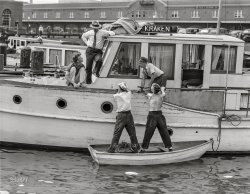
- Smokestack Washington: 1921
- Washington, D.C., circa 1921. "Aerial view looking toward Capitol and ... First World War vintage that were ubiquitous features of DC landscape up until the late 1960s. The neighbor to the right is DAR ... Posted by Dave - 09/12/2011 - 2:34pm -
![Smokestack Washington: 1921 Washington, D.C., circa 1921. "Aerial view looking toward Capitol and Washington Monument." National Photo Company Collection glass negative. View full size.
An Eclipse of the EllipseWhat puzzles me is the photographer's vantage point. No doubt it was from the corner of 18th and E Streets N.W., but was it from the roof of the Department of the Interior or a building that preceded it??
This photo looks to the east. The white building to the left is the headquarters of the American Red Cross. It's still there, but gone is the less-ornate wing to the right with its smokestack. I believe that building was one of the infamous "temporary" office buildings of First World War vintage that were ubiquitous features of DC landscape up until the late 1960s. The neighbor to the right is DAR Constitution Hall, which remains remarkably unchanged to this day. Across the street, of course, is the Ellipse, which you can think of as the "backyard" of the White House. Beyond the Ellipse are landmarks that need no introduction (the Washington Monument, the Old Post Office, the Capitol, Bureau of Engraving, etc.) Perhaps another reader can verify that the two smokestacks just left of center belong to a Pepco generator that powered street cars. Despite the haze, one can faintly see the arched roof of Union Station, appearing on the horizon to the far left.
[There was a tall brick building behind Red Cross HQ. Click below to enlarge. - Dave]
Ordnance OfficeBased on the bit of the 1919-1921 Baist Realty map below (click on it for a larger version), I would guess the photographer was on top of the Ordnance Office of the War Department. It is puzzling that the angle of the photo does suggest quite an elevation and the ordnance office doesn't appear to be a large building: perhaps there was some sort of observation tower on top of the building.
The smokestacks in the distance are indeed the Potomac Electric Power Co. Plant at northeast corner of 14th &B streets N.W.: they are also visible in the background of this Shorpy photo.
Also indicated on the map is the Frazee Potomac Laundry, seen here.
(The Gallery, D.C., Natl Photo)](https://www.shorpy.com/files/images/30461u2.thumbnail.jpg)
- Rooftops of Washington: 1901
- Washington, D.C., 1901. "View of 1st & Delaware N.W., New Jersey Avenue ... Posted by Dave - 02/06/2021 - 10:03am -
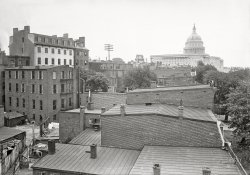
- After the Storm: 1913
- Washington, D.C. "Storm damage. Between 1913 and 1918." Somewhere under all ... Posted by Dave - 09/13/2011 - 4:33pm -
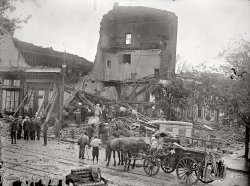
- Washington Flyer: 1925
- 1925. Washington, D.C. "C.H. Milano, Ross School, 5-3/4. Plaza playground." View ... Posted by Dave - 08/31/2012 - 8:20pm -
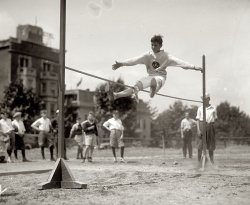
- F Troop: 1928
- Washington, D.C., circa 1928. "Barrister Building, F Street N.W." National ... Posted by Dave - 09/14/2011 - 4:43pm -
![F Troop: 1928 Washington, D.C., circa 1928. "Barrister Building, F Street N.W." National Photo Company Collection glass negative. View full size.
Oh Henry!The Kids got a box of Oh Henry! bars. A whole box, he must be rich! Or he's selling them.
[Or it's his pencil box. - Dave]
I hadn't thought of that one, probably correct since they seem to be coming from or going to School.
Etched in stoneNo adjustable rates mortgages at the Washington Permanent Building Association - 6 percent cast in stone. Lots of patent lawyers and the ever-present cigar store, too.
QualityNice to see a Sign Shop that prides itself on workmanship. I see Jerry has opened his Restaurant up!
Barrister BuildingInfo on the Barrister Building at Shorpy Post: Slush Hour: 1916.
October 1970 (+42), Historical American Building Survey.
Date QuestionHow firm is that 1928 date? All of the cars I can see have an angularity - especially the flat tops of the fenders - that looks more like the late teens/early Twenties. Of course, they could all just be older cars.
[There are mid to late 1920s cars here, with 1928 District of Columbia license plates. Another clue is balloon tires and the number of cars with disc wheels. - Dave]
The littlest flapperThe youngsters very nicely and expensively dressed! The little girl's outfit, with the cloche hat and knee-length coat and fur perfectly copies in scale those worn by the adult flappers of the day!
In the backgroundThere is Smithsonian American Art Museum on the backstage.
Modern view of the place
[At the time, it was the Old Patent Office. - Dave]
Six Per Cent Building The similarity of the Barrister Building and the Washington Permanent Building Association is more than coincidental: both were designed by architect Appleton P. Clark, Jr.
Washington Post, May 11, 1907
M'Gowan Building Sold
Washington Loan and Trust Dispose of Property for $26,000.
The McGowan building, at 629 F street northwest was recently sold to the Washington Six Per Cent Building Association by the Washington Loan and Trust Company through the firm of Stone & Fairfax. It is understood that the price paid was $26,000. The Six Per Cent Building Association moved into the McGowan building not long ago under a lease.
The property has frontage of twenty-six feet seven inches on F street, and its 120 feet deep, running back to an alley. For many years the Washington Six Per Cent Building Association occupied offices in the Second National Bank on Seventh street. It recently left those quarters to make room for the growing business of the bank. The building association is one of the oldest concerns of its kind in the city.
It is thought that the building of the new union station will increase demand for property around Seventh and F streets. Stone & Fairfax have recently sold several buildings in this square.
Washington Post, Aug 25 1912
The Washington Six Per Cent Building Association, to erect an office building at 629 F street northwest. A.P. Clarke, jr., architect, Melton Construction Company, builders. Cost $23,500.
Washington Post, Apr 14, 1931
Capital Building Body 50 Years Old
Small Group Here Organized Permanent Association in Early Part of 1881.
By Thomas M. Cahell.
The Washington Permanent Building Association is now 50 years old. Early in 1881 a small group of men met at Gustave Hartig's hardware store at Seventh and K streets northwest to discuss the formation of a building association, different from any then in operation in the District, in that it was to follow the permanent rather than serial plan.
The permanent plan meant the continuation of business from year to year, instead of a series of periodical settlements as a serial association then operated. The permanent plan was adopted from Philadelphia, where all necessary information was obtained.
After a few conferences at the Hartig store, a larger meeting was held at Dismer's Saengerbund Hall, where preliminaries for drafting a constitution were settled. On May 14 the first meeting of the association convened at German Hall, on Eleventh street, between F and G streets northwest.
…
The association's first office was above the German-American National Bank, at Seventh and F streets northwest, where Hecht's store now stands. In 1884 it occupied half of the first floor of the Pacific Building, now a part of the Hecht's store. Office hours were then from 3 to 5 p.m. In 1898 it moved to the Second National Bank Building, at 509 Seventh street northwest, occupying half of that building until March, 1907, when it acquired its first home, the McGowan Building at 629 F street northwest. At this time the minutes of the association were changed from German to English. In 1913 the association's building was razed for its present modern banking office on the site, its temporary headquarters being at 631 F street northwest during the construction period.
Waiting for Il Duce.I expect it's just my fevered imagination but the balcony shown below just looks as if it's waiting for a suitable dictator to address the adoring masses.
+88Below is the same view from May of 2016.
(The Gallery, Cars, Trucks, Buses, D.C., Kids, Natl Photo)](https://www.shorpy.com/files/images/33447u.thumbnail.jpg)
- Window on Washington: 1939
- An uncredited view of Washington, D.C., circa 1939. Who'll be the first to drop a pin on the map and ... Posted by Dave - 09/26/2017 - 1:48pm -
![Window on Washington: 1939 An uncredited view of Washington, D.C., circa 1939. Who'll be the first to drop a pin on the map and tell us where this is? In the meantime, let's settle in and wait for Lars Thorwald to get home. 4x5 inch acetate negative. View full size.
Settle down over there!Don't let Dave's oblique reference put a Burr under your saddle!!!
"Virtually" the same view, today.Googlemap 3D https://goo.gl/maps/6QUTkm2E2352
Preview:
Grace Under PressureI don't see Lisa anywhere. Not investigating, I take it.
Nice view though.
You wait for Lars.I'm waiting for Miss Torso.
InterestingWhat, I wonder, is the oddly-shaped roof covering?
[A turret, perhaps over a stairwell. - Dave]
Burke ParkThis is taken from the roof or rear window of a building at 1121 12th Street NW, looking south across Burke Park at buildings on L Street.
The statue pedestal visible is for Edmund Burke.
John Nourse HouseThe building at far left appears to be the John Nourse House at 1107 Massachusetts Ave., NW. It was built c.1840 and is currently on the market with an asking price of $3.6M.
Hambo's right!Based on the sight lines, the photo was taken from the southeast corner of the rooftop of the eight story building at 1125 12th St. NW. The odd-shaped corner of the brick building on the right is the northeast corner of the seven story building at 1116 12th St. NW. The elongated turret has been trimmed but the street-side peak still survives on the townhouse at 1113 Massachusetts Ave. NW. The buildings to the left, as well as those across the street are long gone.
(The Gallery, D.C.)](https://www.shorpy.com/files/images/SHORPY-8b15222a.thumbnail.jpg)
- School for Secretaries: 1920
- 1920. "Washington School for Secretaries. Typing room." Note the Dictaphone in the middle. Harris & Ewing Collection glass negative. View full size.
Alice Adams This makes me think of the very depressing end of "Alice Adams" when sh ... Posted by Dave - 08/22/2012 - 9:31pm -
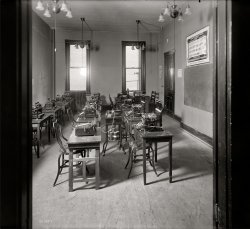
- Washington Water: 1935
- July 1935. "Outside water supply, Washington, D.C. Only source of water supply winter and summer for many houses ... our yard? We renovated the garage behind our Southeast DC rowhouse last year and removed a non-functioning pump to make room (barely!) ... Posted by Dave - 09/13/2011 - 10:42pm -
![Washington Water: 1935 July 1935. "Outside water supply, Washington, D.C. Only source of water supply winter and summer for many houses in slum areas. In some places drainage is so poor that surplus water backs up in huge puddles." These municipal water taps (or pumps -- they have crank handles) appear in several photos from this series. I wonder if any survive. 35mm negative by Carl Mydans. View full size.
Not such an ancient thingWhen I was 3 or 4 (in 1961 or 1962) my elderly farmer's wife babysitter in Benton Harbor, Michigan, had only an outside pump like this. And an outhouse, of course. Years later, when we visited them, their kids had moved them into a two storey frame house with indoor plumbing, nearby. Very uptown!
Garden hoseI just really looked at this in full size, and see she's wearing stockings. Good Lord - stockings to go pump some water to wash the dishes after dinner.
Sometimes I think people try so hard it's ... poignant.
They survive!One of the Capitol Hill NE houses my wife and I (unsuccessfully) bid on had one. Red in color (didn't look to see if the paint was original or not), it still works and is now protected in a newer garage. It was one of the great features of the house.
[Fascinating. Was it more like a pump or a faucet? What did the lettering say? I wonder if the crank operated a valve below ground level, as a safeguard against freeze damage. Questions, questions. - Dave]
re: Garden HoseMy grandma wore those. She was a hardworking farm wife and her legs bore the evidence: varicose veins. The stockings (support hose) provided some therapeutic relief and cosmetic peace of mind.
Speculation, but ...I think you nailed it Dave. I bet it also drained back to below grade, whenever it was shut off.
Re: They survive!Because we didn't own the place, we didn't let the water run for longer than a second, but I got the impression that it operated more like a faucet based on the solid flow of water coming out.
If I remember correctly, you moved the handle down and towards you. That moved the faucet head moved down and the water poured out. If you look at the image, you can see how the rectangular plate behind the faucet head is roughly the same size as the piece behind it. (I don't know the proper terminology.) You can see the empty squarish space above the faucet head and imagine how the metal faucet head would slide down to get where it is.
I hadn't thought about freeze damage... we were all just so amazed by this cool piece of history. I can't remember what the pump said. I really wish I had kept the photos I took of it, but when we didn't get the house, I deleted them all.
If you're interested, I can send you the address if you want to drop by and bug the new owner.
Want the one in our yard?We renovated the garage behind our Southeast DC rowhouse last year and removed a non-functioning pump to make room (barely!) for our car. I've held on to the remains, but it may be time to send it to the dump. The lettering is partially illegible, but the word CLIMAX is printed clearly in a semicircle on top with words to the effect "C.M. KEMP MFG. CO. BALTO MD" below. I don't know how it worked, but I can see that about 2 feet of the pump was originally below grade.
(The Gallery, Carl Mydans, D.C.)](https://www.shorpy.com/files/images/8a00366a.thumbnail.jpg)
- Washington Wizard: 1925
- August 8, 1925. "Dr. H.W. Evans, Imperial Wizard of the Ku Klux Klan, K.K.K. parade, Washington." National Photo Company glass negative. View full size.
Heritage of Hate During my mother's childhood, the family had to pick up and move i ... Posted by Dave - 06/12/2014 - 1:10pm -
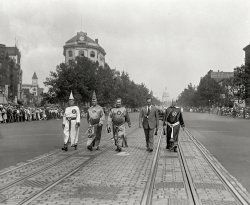
- Washington Masonic Memorial: 1923
- ... in the place despite having spent the last thirty years in DC.
Comparing the background views, the train station is all but unchanged ... Posted by Dave - 02/23/2013 - 3:09am -
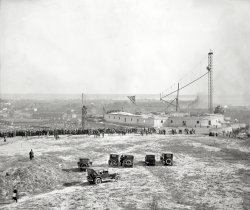
- Redwater in Washington: 1917
- Washington, D.C., circa 1917. "Indians: Redwater and group." My headdress was ... Posted by Dave - 10/27/2019 - 3:25pm -
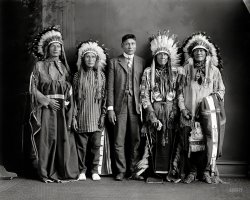
- Parting Glances: 1920
- Washington, D.C., circa 1920. "729 12th St., Washington Times." Various shades ... Posted by Dave - 08/13/2023 - 3:25pm -
![Parting Glances: 1920 Washington, D.C., circa 1920. "729 12th St., Washington Times." Various shades of Twelfth Street. 8x6 inch glass negative, National Photo Company Collection. View full size.
Wall BetweenI would hazard a guess that there is a wall between the woman and young boy. If you follow the line between "painted" and "unpainted" you will see that the width between the windows is farther apart. Also the chimney above, and the two stores below suggest some sort of support wall that would have to go all the way up.
MessengersBicycles, a motorcycle and a messenger office. Pure chance, or a cunning business plan?
Cleveland MotorcycleThat's a production motorcycle from the Cleveland Motorcycle Co.
Questions indeedIs that young blurry boy only wearing one roller skate? Is the other young child telling the headless phantom motorcycle rider to shush?
Must say I love the "lace" and tassels on the Shade shop.
Possible SlumlordAndrew Murray the builder doesn't take very good care of his property.
Window on my WorldBuster Brown in the window above the deli seems to be looking at the motorcycle. Wondering if he is related to the woman in the window next to him, or if there is a wall between them and they are in different apartments.
So many questions, so little timeAre the shutters seen on some of the buildings actually used? Or are they just decorative as are modern shutters are?
Why don't the brick stone buildings have shutters?
Is that some sort of prototype motorcycle?
Are the people in the windows family members of the proprietors of the businesses below?
Is the boy in front of the messenger service an employee?
BTW, I just love photos like this; an honest and unfettered look into a past long gone.
Ahead of the timesLike the bike propped against the building. Owner has his bars flipped and his seat laid back -- cutting edge!
Tri-LevelWhat a mesmerizing photo; one can conjure up at least three scenarios that fit what we see here. The pride of the gentleman inside the Builder's office watching his son leave; the parting of two friends (or lovers); is the rider embarking on a grand adventure; who is the rider, really? The more you look the deeper the stories become. Olde photos are magic.
Ghost RiderTenants checking out the ghost on the motorcyle seems to be the most likely scenario.
The Phantom PhootSo what's that disembodied upside-down foot above the third floor windows of #731?
Taken for a ride in another senseI suspect that the owner of 729 hired the same Washington housepainter that I did.
Bicycle BrakesThe bike leaning against the Murray/McGregor office shows no evidence of brakes, coaster or hand. When did bicycles begin to have braking systems (other than putting your feet down)?....some Shorpyite out there knows.....
King Cola, the Royal DrinkNot much you can find about this brand, except that it was sued to death by the Coca-Cola Company for its use of the word "cola." How did Pepsi ever survive the same predicament?
[The defendant's sin was not the use of the word "cola" but rather its Spencerian-script logo (below), which was a frank imitation of the Coca-Cola trademark. Coca-Cola's legal blitzkrieg also took aim at Koke, Cold-Cola, Koca-Nola and Ko-Kola. - Dave]
Dividing lineI love that only half of the building has been freshly painted. The other half - the builder's half does not instill confidence in his work.
Looks like the kid on one roller skate leaped from his ghost position to where he is now.
Boys and bikesYou can tell by his blurry foot that the driver is kickstarting his bike. This is an activity that always attracts kids. There's something irresistible about the roar of the engine. The little boy standing behind the bike is thinking, "Someday I'm gonna get me one of those..." I've seen this happen a million times.
My Side versus Your SideIt is pretty clear that the owners of 729 and 731 have a different philosophy of exterior maintenance. What a geometrically precise paint line between them.
One SkateI bet the other roller skate is on the ghost of a kid spinning just on front of the steps. The rider is a blur because he's trying to kick start the bike. Upstairs grumpy, and the two men are much more interested in the photographer.
These are really neat old photos, I'm glad I found the web site.
Honesty of Purpose
Washington Post, April 8, 1911.
Special Notices
Announcement.
The family of the late John McGregor, builder, of 729 Twelfth street northwest, desire to inform the public that the business will be carried on by his successor, Mr. Andrew Murray, who has been with Mr. McGregor for the past thirteen years. They trust that the same patronage extended to the late Mr. McGregror will continue to be shown to Mr. Murray. In reference to the above, I hope, by strict attention to business and the same honesty of purpose that characterized Mr. McGregror's work, to merit the confidence and patronage of his friends and the public generally. Respectfully,
Andrew Murray,
729 Twelfth street northwest.
Shannon & LuchsHoly cow! The Shannon & Luchs For Sale sign on 731 caught my eye. They were the dominant real estate company in Fairfax County, Virginia, when I was growing up there in the 1980s and '90s. I still remember their radio jingle: "It takes more than luck / it takes Shannon & Luchs." I had no idea they had this long a history. They seem to have been acquired by Polinger in 1993, but I know they were still going by the S&L name at least until the late '90s.
Cleveland motorcycleThe motorcycle in the photo is a Cleveland A2, which was manufactured by the Cleveland Motorcycle Manufacturing Company, located in the Ohio city of the same name between 1915 and 1925. The A2 was powered by a 220cc two-stroke engine mounted transversely in the frame, with a worm drive to power the countershaft sprocket for final chain drive. The shaft exited the two-speed gearbox and extended past the rear downtube to drive the the magneto, hung just forward of the rear wheel.
In 1920 the A2 grew larger, adding footboards, incorporated fuel/oil tank and wider fenders. The weight increased in 1921 with a larger fuel/oil tank and seat and a battery. To offset the additional weight, engine capacity was increased to 270cc. In 1923 a sportier model was offered - the Model E, which featured a battery and electric lights.
Although the Cleveland looked flimsy compared to the big V-twins offered by other US manufacturers, their light weight (68 kg) and moderate power (3.5 bhp and 30 mph top speed) combined for easy riding. The main market of the A2 were students, women and businesses who employed couriers and light delivery riders. The low price ($150) was cheaper than comparative bikes offered by other manufacturers. The A2 was replaced in 1925 by the 350cc Model F.
(The Gallery, Bicycles, D.C., Motorcycles, Natl Photo, Stores & Markets)](https://www.shorpy.com/files/images/SHORPY_28800u.thumbnail.jpg)























